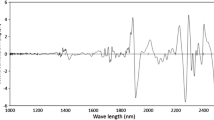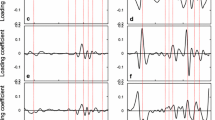Abstract
Attenuated total reflectance (ATR) infrared (IR) spectroscopy analyses were performed with silver/white birch (Betula pendula/B. pubescens) and Scots pine (Pinus sylvestris) chips pretreated under alkaline (from 1 to 8% NaOH charge on wood dry solids) conditions to determine the suitability of this method in quickly determining chemical changes caused by varying treatment conditions on wood chemical structure. In addition to the alkali charge, pretreatment conditions varied with respect to temperature (130 and 150 °C) and treatment time (from 30 to 120 min). The spectral data of pretreated wood samples were compared to those of untreated reference samples, and the effects of the pretreatments conducted were determined based on these data. Results indicated that the most essential phenomena taking place during alkaline pretreatments could be detected by applying this simple and rapid spectral method requiring only a small sample amount. Such information included, for example, the cleavage of common lignin and carbohydrate bonds together with the significant removal of organics, especially hemicelluloses during pretreatments.






Similar content being viewed by others
References
Hardy J (2004) Green chemistry and sustainability. In: Stevens CV, Verhé R (eds) Renewable bioresources—scope and modification for non-food applications. John Wiley & Sons Ltd, Chichester, pp 1–29
Kamm B, Kamm M, Gruber PR, Kromus S (2006) Biorefinery systems—an overview. In: Kamm B, Kamm M, Gruber PR, Kromus S (eds) Biorefineries—industrial processes and products, Status Quo and Future Directions. Wiley-VCH Verlag GmbH & Co. KGaA, Weinheim, pp 3–40
van Santen RA (2007) Renewable catalytic technologies—a perspective. In: Centi G, van Santen RA (eds) Catalysis for renewables—from feedstock to energy production. Wiley-VCH Verlag GmbH & Co. KGaA, Weinheim, pp 1–19
Alén R (2011) Principles of biorefining. In: Alén R (ed) Biorefining of Forest Resources Paper Engineers’ Association, Helsinki, pp 18–114
Goldstein IS (1981) Organic chemicals from biomass. CRC press, Boca Raton
Sinsky AJ (1983) Organic chemicals from biomass: an overview. In: Wise DL (ed) Organic chemicals from biomass. Benjamin/Cummins Publishing Company, pp 1–67
Mateos-Espejel E, Moshkelani M, Keshtkar M, Paris J (2011) Sustainability of the green integrated forest biorefinery: question of energy. J Sci Technol For Prod Proc 1:55–61
van Heiningen A (2006) Converting a kraft pulp mill into an integrated forest biorefinery. Pulp Paper Can 107:38–43
Baijpai P (2012) Integrated forest biorefinery. In: Baijpai P (ed) Biotechnology for pulp and paper processing. Springer, New York, pp 375–402
Moshkelani M, Marinova M, Perrier M, Paris J (2013) The forest biorefinery and its implementation in the pulp and paper industry: energy overview. Appl Therm Eng 50:1427–1436
Ragauskas AJ, Nagy M, Kim DH, Eckert CA, Hallett JP, Liotta CL (2006) From wood to fuels—integrating biofuels and pulp production. Ind Biotechnol 2:55–65
Hämäläinen S, Näyhä A, Pesonen H-L (2011) Forest biorefineries—a business opportunity for the Finnish forest cluster. J Clean Prod 19:1884–1891
Carvalheiro F, Duarte LC, Gírio FM (2008) Hemicellulose biorefineries: a review on biomass pretreatments. J Sci Ind Res 67:849–864
von Weymarn N (2011) The sugar platform in the wood biorefinery. In: Proceedings of the 3rd Nordic wood and biorefinery conference (NWBC), Stockholm, Sweden: march, vol 22-24, p 138
Lehto JT, Alén RJ (2015) Chemical pretreatments of wood chips prior to alkaline pulping—a review of pretreatment alternatives, chemical aspects of the resulting liquors. and pulping outcomes BioResources 10:8604–8656
Chirat C, Lachenal D, Sanglard M (2012) Extraction of xylans from hardwood chips prior to kraft cooking. Process Biochem 47:381–385
Yoon S-H, Tunc MS, van Heiningen A (2011) Near-neutral pre-extraction of hemicelluloses and subsequent kraft pulping of southern mixed hardwoods. TAPPI J 10:7–15
Luo J, Genco JM, Zou H (2012) Extraction of hardwood biomass using dilute alkali. TAPPI J 11:19–27
Walton SL, Hutto D, Genco JM, van Walsum GP, van Heiningen ARP (2010) Pre-extraction of hemicelluloses from hardwood chips using an alkaline wood pulping solution followed by kraft pulping of the extracted wood chips. Ind Eng Chem Res 49:12638–12645
Yoon SH, van Heiningen A (2010) Green liquor extraction of hemicelluloses from southern pine in an integrated forest biorefinery. J Ind Eng Chem 16:74–80
Jun A, Tschirner UW, Tauer Z (2012) Hemicellulose extraction from aspen chips prior to kraft pulping utilizing kraft white liquor. Biomass Bioenergy 37:229–236
Hendriks ATWM, Zeeman G (2009) Pretreatments to enhance the digestibility of lignocellulosic biomass. Bioresour Technol 100:10–18
Huang F, Ragauskas A (2013) Integration of hemicellulose pre-extraction in the bleach-grade pulp production process. TAPPI J:1255–1261
Martin-Sampedro R, Eugenio ME, Moreno JA, Revilla E, Villar JC (2014) Integration of a kraft pulping mill into a forest biorefinery: pre-extraction of hemicellulose by steam explosion versus steam treatment. Bioresour Technol 153:236–244
Tjeerdsma BF, Militz H (2005) Chemical changes in hydrothermal treated wood: FTIR analysis of combined hydrothermal and dry heat-treated wood. Holz Roh Werkst 63:102–111
Huang A, Zhou Q, Liu J, Fei B, Sun S (2008) Distinction of three wood species by Fourier transform infrared spectroscopy and two-dimensional correlation IR spectroscopy. J Molec Struct 883-884:160–166
Vartanian E, Barres O, Roque C (2015) FTIR spectroscopy of woods: a new approach to study the weathering of the carving face of a sculpture. Spectrochim Acta Part A 136:1255–1259
Mehrotra R, Singh P, Kandpal H (2010) Near infrared spectroscopic investigation of the thermal degradation of wood. Thermoch Acta 507-508:60–65
Popescu C-M, Popescu M-C (2013) A near infrared spectroscopic study of the structural modifications of lime (Tilia cordata Mill.) wood during hydro-thermal treatment. Spectrochim Acta Part A 115:227–233
Chen Z, Hu TQ, Jang HF, Grant E (2015) Modification of xylan in alkaline treated bleached hardwood kraft pulps as classified by attenuated total-internal-reflection (ATR) FTIR spectroscopy. Carbohydr Polym 127:418–426
Pizzo B, Pecoraro E, Alves A, Macchioni N, Rodrigues JC (2015) Quantitative evaluation by attenuated total reflectance infrared (ATR-FTIR) spectroscopy of the chemical composition of decayed wood preserved in waterlogged conditions. Talanta 131:14–20
SCAN-CM 40:94 (1994) Wood chips for pulp production—size distribution, Scandinavian Pulp, Paper and Board Testing Committee, Stockholm
TAPPI T280 pm-997 (1999) Acetone extractives of wood and pulp, TAPPI Press, Atlanta
TAPPI T222 om-98 (1998) Acid insoluble lignin in wood and pulp TAPPI Press, Atlanta
TAPPI T250 um-00 (2000) Acid-soluble lignin in wood and pulp, TAPPI Press, Atlanta
Swan B (1965) Isolation of acid-soluble lignin from the Klason lignin determination. Svensk Papperstidn 68:791–795
Lehto J, Alén R (2013) Alkaline pre-treatment of hardwood chips prior to delignification. J Wood Chem Technol 33:77–91
Lehto J, Alén R (2015) Alkaline pre-treatment of softwood chips prior to delignification. J Wood Chem Technol 35:146–155
Alén R (2000) Basic chemistry of wood delignification. In: Stenius P (ed) Forest Products Chemistry Fapet Oy, Helsinki, pp 58–104
Traoré M, Kaal J, Cortizas AM (2016) Application of FTIR spectroscopy to the characterization of archeological wood. Spectrochim Acta Part A 153:63–70
Fan M, Dai D, Huang B (2012) Fourier transform infrared spectroscopy for natural fibres. In: Salih S (ed) Fourier transform—materials analysis. InTech, Shanghai, pp 45–68
Wang P, Fu Y, Shao Z, Zhang F, Qin M (2016) Structural changes to aspen wood lignin during autohydrolysis pretreatment. BioResources 11:4086–4103
Shimizu S, Akiyama T, Yokoyama T, Matsumoto Y (2017) Chemical factors underlying the more rapid β-O-4 bond cleavage of syringyl than guaiacyl lignin under alkaline delignification conditions. J Wood Chem Technol 37:451–466
Funding
Financial support was from the Maj and Tor Nessling Foundation (grant number 201700063) and Finnish Cultural Foundation (within the framework of Foundations’ Post Doc Pool, grant number 00170038) (Joni Lehto), and from the European Union in the context of the goals of “Europe 2020 Strategy” and in the framework of “Human Capital Operational Program No. POKL.04.0300-00-042/12-00” (Teresa Kłosińska and Michał Drożdżek).
Author information
Authors and Affiliations
Corresponding author
Additional information
Publisher’s Note
Springer Nature remains neutral with regard to jurisdictional claims in published maps and institutional affiliations.
Rights and permissions
About this article
Cite this article
Lehto, J., Louhelainen, J., Kłosińska, T. et al. Characterization of alkali-extracted wood by FTIR-ATR spectroscopy. Biomass Conv. Bioref. 8, 847–855 (2018). https://doi.org/10.1007/s13399-018-0327-5
Received:
Revised:
Accepted:
Published:
Issue Date:
DOI: https://doi.org/10.1007/s13399-018-0327-5




